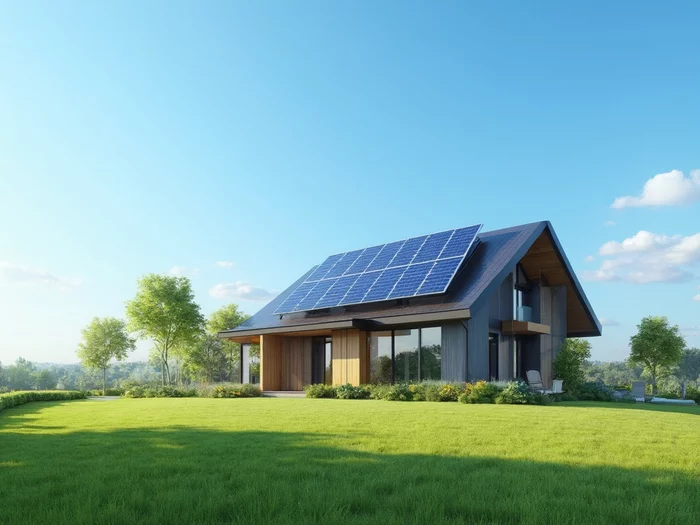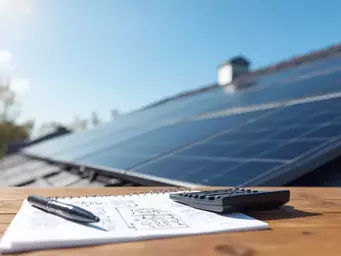Solar Panels: How They Work

Posted on: 2025-10-08
By: Evelyn Tran
Are you ready to harness the power of the sun for your home? Understanding solar energy and the technology behind it can unlock significant benefits for both your wallet and the environment.
What You Will Learn
- The core components of solar panels, including photovoltaic cells and their roles in energy conversion.
- How the photovoltaic effect enables solar panels to generate electricity from sunlight.
- The step-by-step process of converting sunlight into usable energy for your home.
- The differences between monocrystalline, polycrystalline, and thin-film solar panels to help you make informed choices.
- The numerous advantages of installing solar panels, such as cost savings and increased property value.
- The latest trends in solar technology, including battery storage and smart solar systems.
Solar Panel Conversion Process & Key Benefits
Discover the step-by-step journey of sunlight to electricity and the powerful advantages of embracing solar energy for your home.
Energy Conversion Process
- Sunlight Absorption: Panels absorb sunlight, converting it to DC electricity.
- Inverter Conversion: DC electricity goes to an inverter, changing it to AC for home use.
- Energy Use: AC powers home; excess can be sent to the grid or stored.
Key Advantages of Solar Panels
- Cost Savings: Lower utility bills & government incentives.
- Environmental Impact: Reduced carbon footprint, sustainable energy.
- Energy Independence: Control energy needs, less grid reliance.
- Increased Property Value: Homes with solar see a rise in market value.
Types of Solar Panels
- Monocrystalline: High efficiency, sleek, preferred by homeowners.
- Polycrystalline: More affordable, slightly less efficient, solid performance.
- Thin-film: Lightweight, flexible, for unique installations, lower efficiency.
Future Trends in Solar Energy
- Increased Efficiency: Continuous advancements in technology.
- Battery Storage: More homeowners storing excess energy.
- Smart Solar Systems: Easier monitoring and management.
- Growing Adoption: More families and businesses switching to solar.
Understanding Solar Energy: How Solar Panels Function
Solar energy is an incredible resource that harnesses the power of the sun to provide clean, renewable energy. Understanding how solar panels function is the first step for any homeowner considering this sustainable option. At Longi Solar Solutions, I often emphasize the significance of grasping these fundamentals, as it empowers you to make informed decisions about your solar journey!
From the materials that compose the panels to the intricate processes that convert sunlight into usable electricity, let's dive into the essentials of solar panel technology.
The Basics of Solar Panel Technology
At its core, solar panel technology operates based on the principles of the photovoltaic effect. But before we get into that, let’s explore what these panels are actually made of.
What Are Solar Panels Made Of?
Solar panels typically consist of several key components, including:
- Photovoltaic (PV) cells: The heart of the solar panel, converting sunlight into electricity.
- Glass: Protects the PV cells from the elements while allowing light to pass through.
- Frames: Usually made of aluminum, offering structural support and durability.
- Backing material: Provides insulation and protects the solar cells.
These components work together to create a system capable of efficiently capturing and converting solar energy!
The Photovoltaic Effect Explained
The photovoltaic effect is a fascinating process where certain materials, like silicon, generate electricity when exposed to sunlight. Essentially, when sunlight hits the solar cells, it excites electrons, creating an electric current. For a more detailed explanation of how solar power works, you can refer to resources from National Grid. This is the magic that allows solar panels to produce energy, and understanding this concept can help you appreciate the value of investing in solar technology!
How Solar Panels Convert Sunlight into Energy
Now that we know what solar panels are made of and how they work at a basic level, let’s look at the step-by-step process of how they convert sunlight into energy.
Step-by-Step Process of Energy Conversion
- Sunlight absorption: Solar panels absorb sunlight and convert it to direct current (DC) electricity.
- Inverter conversion: The DC electricity is sent to an inverter, which converts it to alternating current (AC) electricity, the type used in homes.
- Energy use: The AC electricity powers your home’s electrical system, and any excess energy can be sent back to the grid or stored for later use.
This process happens continuously throughout the day, allowing you to harness the sun's energy efficiently! To learn more about how photovoltaics and electricity are generated, consider exploring information from the U.S. Energy Information Administration (EIA).
Types of Solar Panels: Which One Is Right for You?
When it comes to choosing the right solar panel for your home, you essentially have three main options:
- Monocrystalline panels: Known for their high efficiency and sleek appearance, these are often the preferred choice for homeowners.
- Polycrystalline panels: Generally more affordable, these panels are slightly less efficient but still offer solid performance.
- Thin-film solar panels: Lightweight and flexible, these panels are ideal for unique installations but typically have lower efficiency.
Considering your energy needs and budget will help you decide which solar panel type aligns with your goals!
Understanding Photovoltaic Cells and Their Role in Solar Energy Systems
Photovoltaic cells, as the core of solar panels, play a pivotal role in your solar energy system. These cells are crucial for transforming sunlight into electricity, and their efficiency rates can vary based on material quality and manufacturing processes. By opting for high-quality photovoltaic cells, you can enhance the overall efficiency of your solar system, leading to greater energy savings over time. You can delve deeper into how solar panels work by reviewing resources from the Union of Concerned Scientists.
With the right knowledge, you can confidently navigate your options and make informed decisions on your solar journey! Explore more about solar energy with Longi Solar Solutions, where we’re here to guide you every step of the way.
 Ready to unlock the potential of solar energy for your home? Understanding the financial landscape o
Ready to unlock the potential of solar energy for your home? Understanding the financial landscape o
 As you contemplate the shift to solar energy, consider this: a comprehensive understanding of the co
As you contemplate the shift to solar energy, consider this: a comprehensive understanding of the co
 Choosing the right solar installer can significantly impact your renewable energy journey. Are you r
Choosing the right solar installer can significantly impact your renewable energy journey. Are you r
